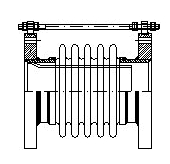 |
Satish Lele lelepiping@gmail.com |
View this page as YouTube Video Presentation



The most common application for a single axial bellows expansion joints is to absorb axial movements of a straight pipe between main anchors. This axial bellows expansion joint should be placed near one anchor and guides should be utilized to ensure proper alignment and movement control.
Under pressure, single bellows expansion joint exerts a reaction force on the adjoining pipe. The force is calculated as: (Mean Effective Area) x (Line pressure)
This reaction force should be absorbed by anchors at both ends of the pipe section in which this expansion joint is installed. In a piping system with several expansion joints the system should be broken up by intermediate anchors into sections with an single bellows expansion joint in each section. The anchors at the end of the piping system are designed to absorb the full reaction force (pressure thrust force) of the expansion joints. Intermediate anchors are designed to resist forces due to friction, uneven cooling etc.
When the axial movements of the piping run exceeds the capacity of a single bellow expansion joint, a double joint with support foot ( intermediate anchor) welded to a centre spool can be used. This type of double bellows axial expansion joint is located in the centre of the piping run and each single joint on either side absorbs the axial movement of the section of the piping within which it is located.
The single axial bellows are designed to compensate for axial displacements. Slight lateral movements are acceptable, but reduce the cyclic life expectancy if the allowable axial movement is used at the same time. The lateral movement on a single bellows expansion joint produces the highest forces and the most detrimental movement for this type of expansion joint. For this reason these joints should be installed coaxially with the piping. An axial bellows expansion joint should be made to avoid lateral movements by providing directional main anchors at ends (two-direction supports acting at right angles to the axis of the pipe) to direct the piping growth in to the single bellows expansion joint only in axial direction.
- Advantages:
- Simple and most economical type of expansion joint.
- No change in for direction required.
- Compact requiring minimum space for installation.
- Available in a single or universal design.
- Economical construction.
- Will not absorb pressure thrust unless tie rods are used.
- Designed for moderate axial movement.
- Requirements:
- Strong anchors required.
- Pipe guides essential to direct the movement.
- Several axial expansion joints are required for large movements.
- Several anchors and guides required for long run pipe sections.
 to get all the information as a eBook
to get all the information as a eBook
